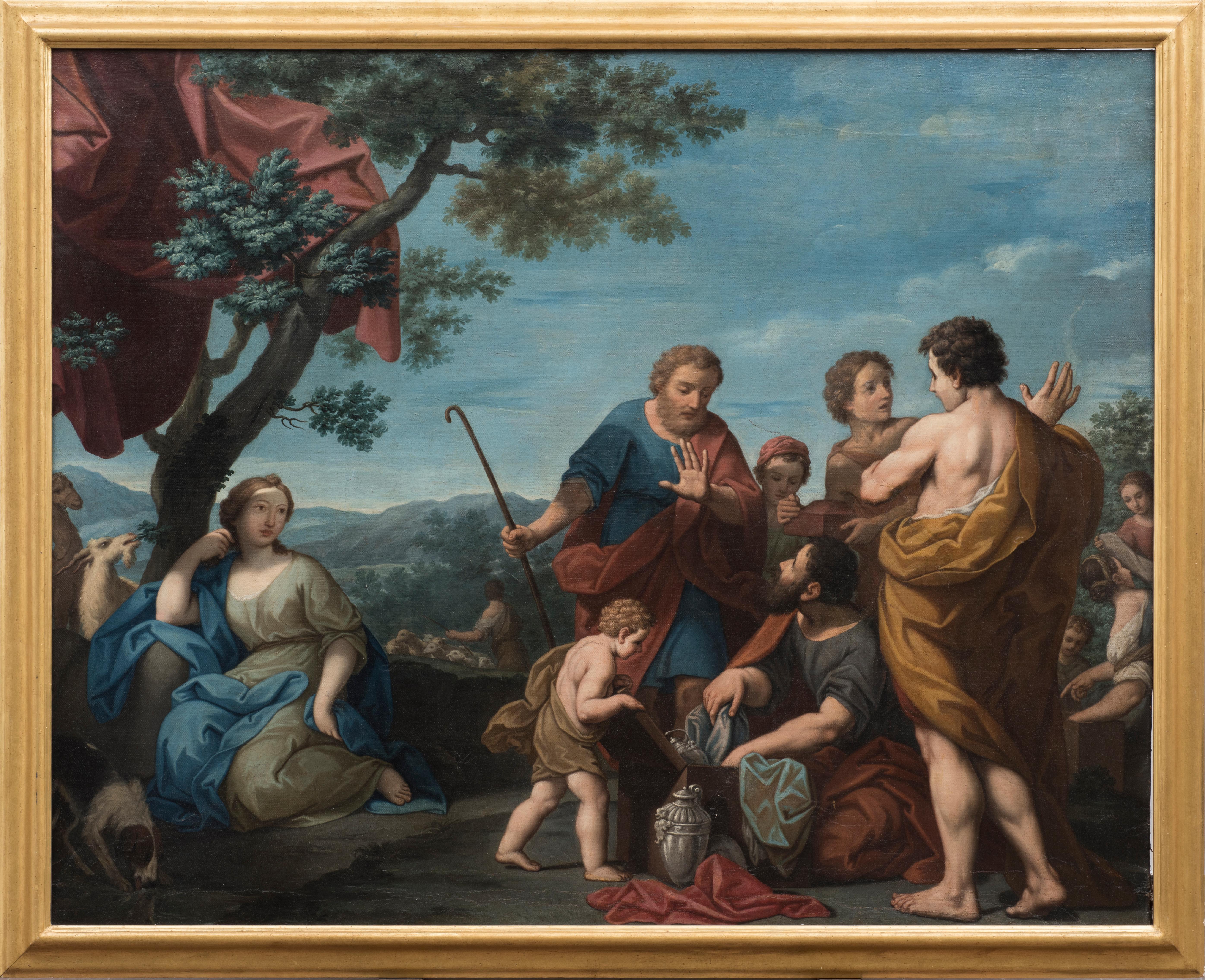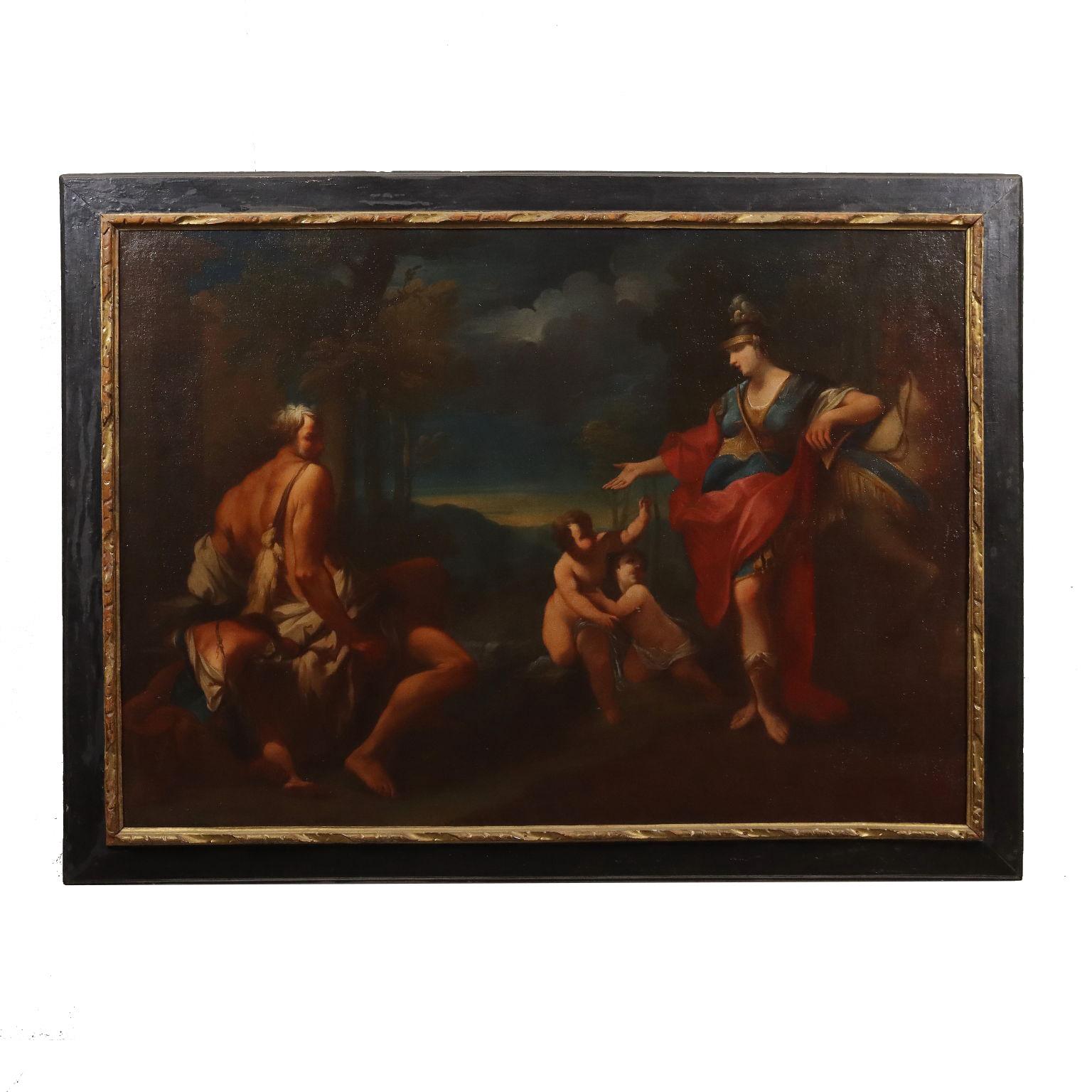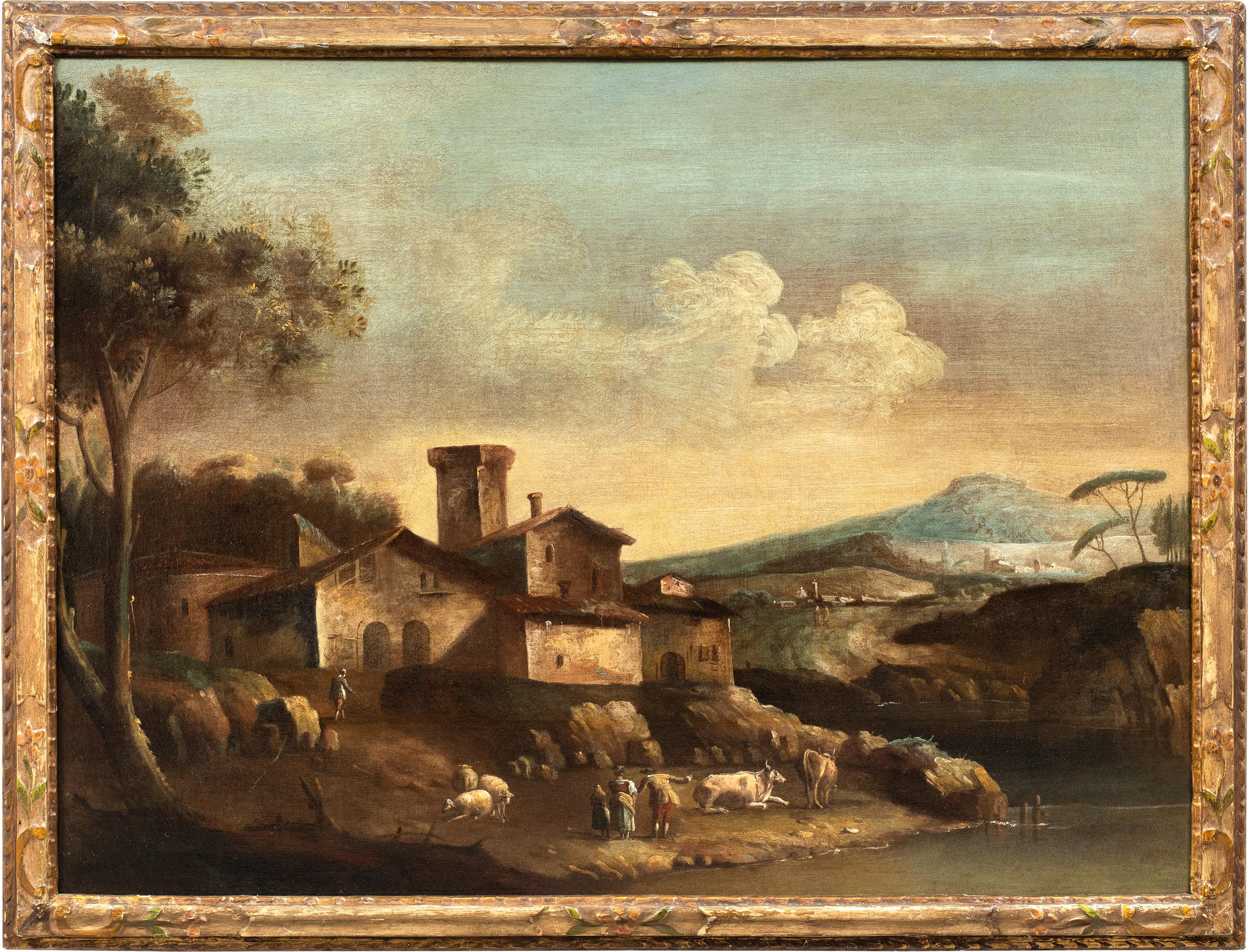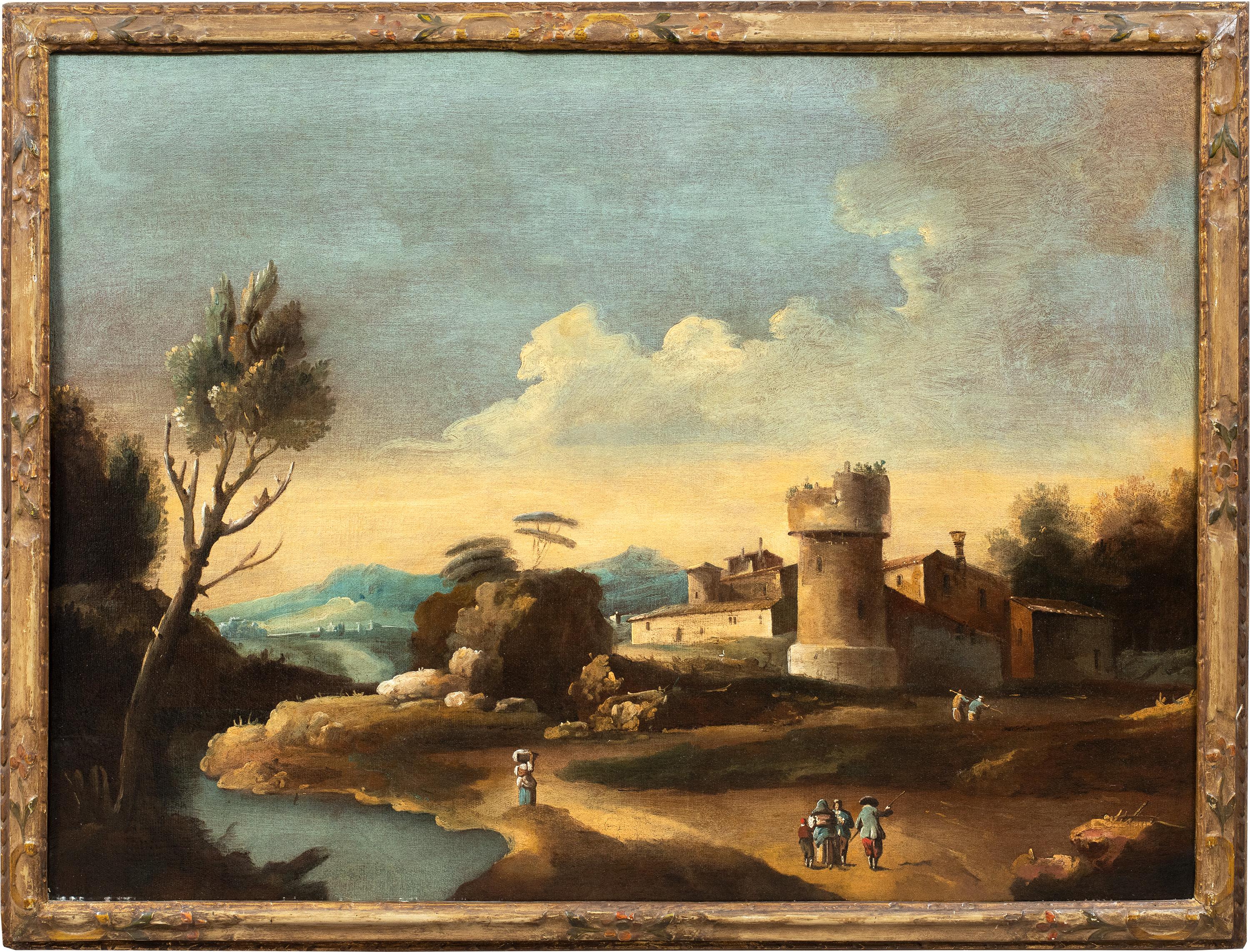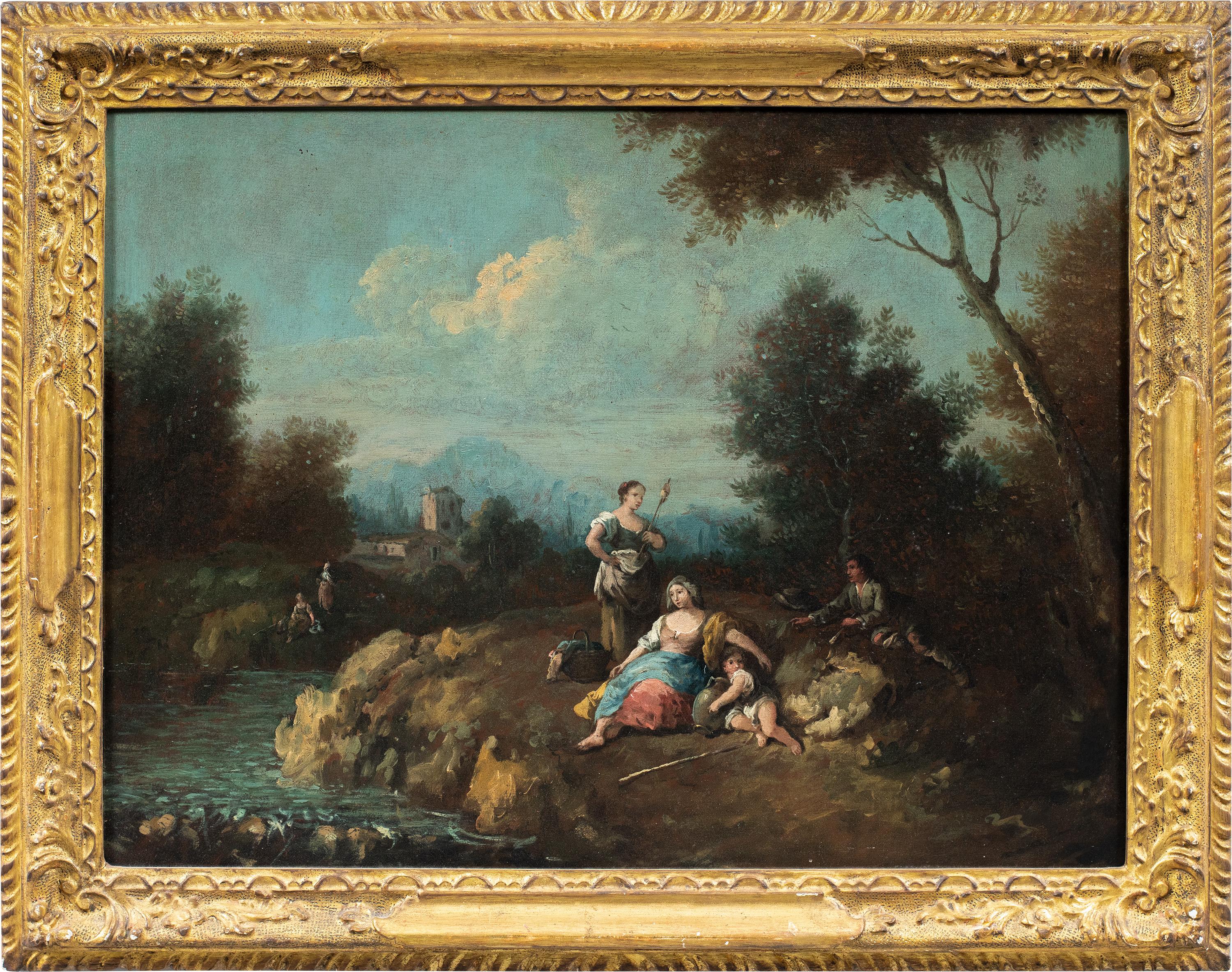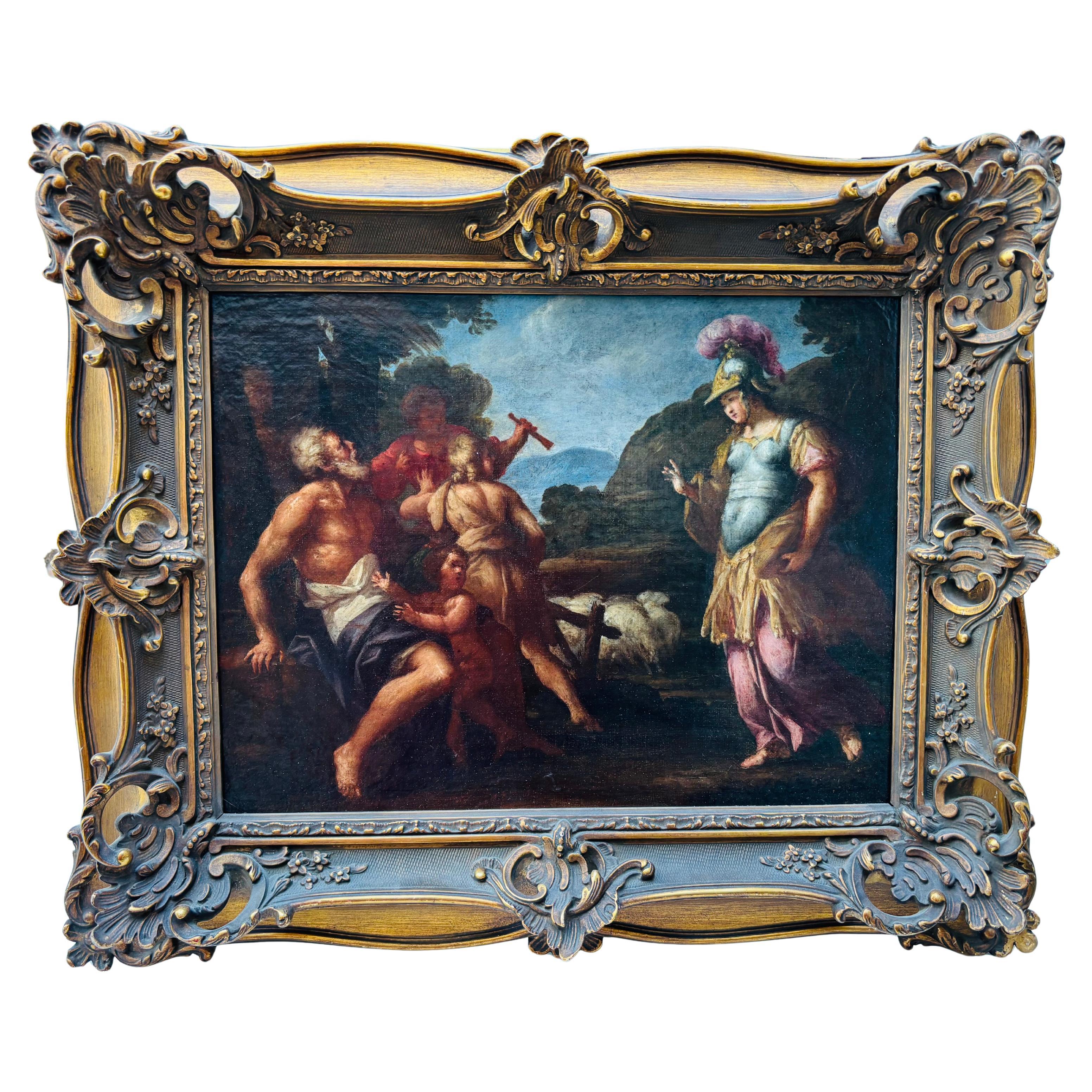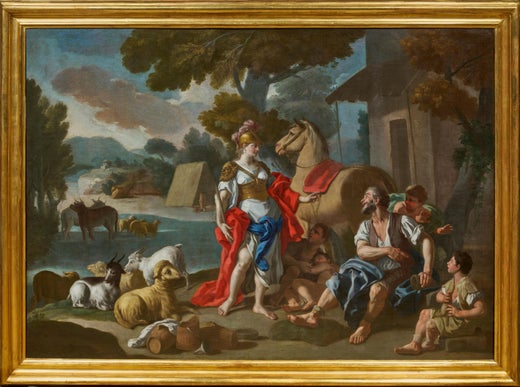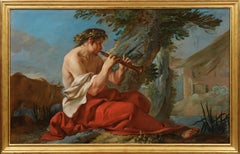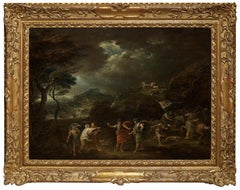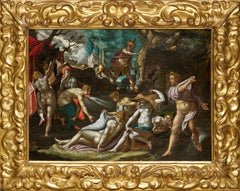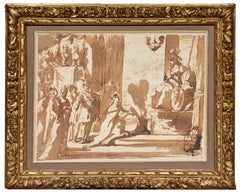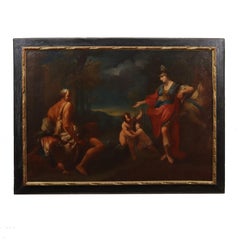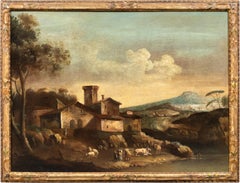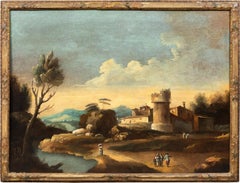Items Similar to Erminia and the Shepherds, a painting by Francesco de Mura (Napoli 1696 - 1782)
Want more images or videos?
Request additional images or videos from the seller
1 of 11
Francesco de MuraErminia and the Shepherds, a painting by Francesco de Mura (Napoli 1696 - 1782)ca. 1760
ca. 1760
$87,287.59
£64,617.87
€73,500
CA$120,261.26
A$133,988.02
CHF 69,948.08
MX$1,626,793.09
NOK 879,201.79
SEK 831,059.28
DKK 559,642.01
About the Item
In this masterly painting, Francesco de Mura presents the meeting of Erminia and the shepherds, a famous episode taken from the seventh canto of Torquato Tasso's Jerusalem Delivered. The artist is offering us a synthesis of the chromatic seductions of the rococo and neoclassical influences and presents a luminous, quiet version of this episode, in which the frieze of the main characters stands out against an Arcadian landscape.
1. Francesco de Mura, a rococo heir to the Neapolitan Baroque and a precursor of Neoclassicism
Francesco de Mura was born and died in Naples in 1696 and 1782 respectively. Like his contemporaries Giambattista Tiepolo (1696 - 1770), William Hogarth (1697 - 1764) and François Boucher (1703 - 1770), he is strongly, justifiably identified with his native place, to the extent that his art can be said to represent that place in his time.
After a short apprenticeship in the studio of the painter Domenico Viola, De Mura joined, at the age of 12, the studio of Francesco Solimena (1657 - 1747), the leading figure in Neapolitan painting since Giordano's death in 1705. He was to be durably influenced by Solimena's painting, although from 1730 onwards his art gradually began to differ, with a lighter chromatic range and a greater attention to the environment in which his characters are depicted.
Much of his work produced around 1730, was unfortunately lost to Allied bombing in 1945, when the abbey of Mont Cassin, for which he had produced over thirty paintings and frescoes, was bombed.
In 1742-1743, he spent 18 months at the court of Turin, where he had been invited by King Charles-Emmanuel III of Savoy. During this stay, he was influenced by other painters working for the monarch, in particular Carle van Loo (1705 - 1765) and Corrado Giaquinto (1703 - 1766). It was in Turin that his palette became definitively clearer; back in Naples, he asserted his style, which combines the lightness and dynamism of rococo with neoclassical-inspired forms. His characters are distinguished by their discreet, measured gestures, their studied attitudes subtly conveying their emotions in a pre-romantic manner.
In numerous compositions inspired by mythology, ancient history but also by Jerusalem Delivered, De Mura echoes the theatrical and operatic subjects of Pietro Metastasio, whose artistic ideals and cultural sensibility he shares. These works, to which the present one belongs, are characterized by the clarity of their composition, the elegance of forms and attitudes, all aimed at conveying the feelings that animate their characters.
Endowed with a remarkable longevity for his time, Francesco de Mura continued to paint right up to the end of his life, fulfilling his last commission (a series of door tops for the palace of Caserta) in 1782, the very year of his death.
2. Erminia and the Shepherds, an enchanted interlude in Jerusalem Delivered
Erminia is a princess of Antioch, whose story is told in the sixth and seventh cantos of Jerusalem Delivered. Out of love for Tancredi, Erminia steals the armor of Clorinda, a female warrior with whom Tancredi is in love, to join him and nurse him back to health after a battle in which he has been wounded. Arriving at the Christian camp, she is pursued by horsemen who mistake her for Clorinda.
Carried away by the gallop of her horse, Erminia escapes her pursuers but get lost into a deep forest. In the early hours of the morning, on the banks of the River Jordan, she meets an old shepherd who comforts her by offering her hospitality. She finds inner peace during this bucolic sojourn, melancholically engraving the name of Trancredi on the trees of the forest that surrounds her.
The noise and fury of the battles is followed by the peace of pastoral life, made up of simple pleasures that no one disturbs. Some commentators have seen Erminia as a double of Torquato Tasso, disillusioned by the intrigues of the Ferrara court, which he dreamed of deserting. Like the author, Erminia oscillates between the extremes of euphoria and depression; fragile, she feels as an alien. While the disguise with Clorinda's armor gives her the illusion of a false identity, more courageous and unscrupulous, it does not free her from her true nature: timid, passionate and distraught.
The story of Erminia had also seduced Pietro Metastasio (1698 - 1782), a poet and opera librettist contemporary of De Mura, who is said to have written the libretto for the eponymous serenade premiered in Naples on June 13, 1723 with a music by Scarlatti (with the famous castrato Farinelli in the title role).
3. Description of the artwork and related artworks
Francesco de Mura depicts the decisive moment of the unexpected encounter between Erminia, just off her horse, and an elderly shepherd, in an Arcadian setting on the banks of the Jordan River. The appearance of the two main characters is theatrical, as Erminia's contraposto posture opposes that of the shepherd. This type of composition can be found in other artworks by Francesco de Mura, such as Christ and the Samaritan Woman (1752) in the Seattle Museum.
A comparison with a painting of the same subject by Solimena (recently on sale at Pandolfini - last photo in the gallery) sheds light on the particularity of Francesco de Mura's art. It illustrates the lasting influence of Solimena on his pupil (which can be seen in particular in the figure of the old shepherd, presented by Francesco de Mura in a position very similar to that used by Solimena), but also the fundamental differences in the pictorial approach developed by Francesco de Mura: simplification of forms, lightening of the chromatic range, attention paid to the surrounding landscape.
This artistic evolution - and persistent filiation - can also be illustrated by a youthful work by Francesco de Mura, presented at Sotheby's in 2008. The composition of this early version remains very similar to Solimena's, even if it is greatly simplified by the disappearance of the winged figures.
The very tight framing echoes Solimena's composition, and does not offer the opening onto an idyllic landscape. Erminia, shown taking off her helmet, is rather ungraceful; the shepherd, who is portrayed in a statical manner, does not have the virtuoso elegance he will acquire in the definitive version which we are presenting.
In the painting we are presenting, the artist anticipates neoclassical compositions through the figure of Herminia, who evokes Roman statues of Athena with her helmet, but also through the use of bright colors and simple forms, as in the discreet still life of geometrically shaped containers displayed at Erminia's feet.
Another version of the same subject belongs to the Bavarian State Collections. These two versions are very similar, and it is difficult to determine whether one predates the other. The main differences are Erminia's right hand, which is holding a spear pointing to the ground in the Bavarian version, and the presence of a figure beside the hut in the background.
4. Provenance and framing
This painting was first presented at auction with Sotheby & Co in London in 1963. The sale included paintings from various English private collections (Duke of Fife, Mrs L.M.H Blyth, Mrs J.G Hickson, Baroness J.M De Lagatinerie, Major A. Binny), and it is likely that this painting might be a souvenir of the Grand Tour, of which around 1760 Naples was an essential stopover.
Our painting is presented in an 18th-century Italian carved and gilded wood frame, which is probably its original frame.
Main bibliographical reference :
Arthur R. Blumenthal - In the light of Naples - the Art of Francesco de Mura - Giles London 2016
- Creator:Francesco de Mura (1696-1782, Italian)
- Creation Year:ca. 1760
- Dimensions:Height: 50 in (127 cm)Width: 70 in (177.8 cm)
- Medium:
- Movement & Style:
- Period:1760-1769
- Condition:127 x 177.8 cm (148 x 200 cm framed) 18th century Italian frame in carved and gilded wood Provenance: Sotheby & Co sale (London) 13/03/1963 The work is listed in the Fondation Zeri's photographic archives.
- Gallery Location:PARIS, FR
- Reference Number:1stDibs: LU1568214011232
Francesco de Mura
Francesco de Mura was an Italian painter of the late-Baroque period, active mainly in Naples, Rome and Turin. His late work reflects the style of neoclassicism. He was the favorite pupil of Francesco Solimena. He worked with Domenico Viola and in his atelier, he met his contemporary Mattia Preti. De Mura was a very appreciated and valued artist, known for his religious subjects but also a skilled portraitist. His works of art are exposed in the most important churches in Naples and Italy, and his masterpieces are exposed in many national and international museums.
About the Seller
5.0
Vetted Professional Seller
Every seller passes strict standards for authenticity and reliability
Established in 2020
1stDibs seller since 2021
10 sales on 1stDibs
Typical response time: 3 hours
- ShippingRetrieving quote...Shipping from: PARIS, France
- Return Policy
Authenticity Guarantee
In the unlikely event there’s an issue with an item’s authenticity, contact us within 1 year for a full refund. DetailsMoney-Back Guarantee
If your item is not as described, is damaged in transit, or does not arrive, contact us within 7 days for a full refund. Details24-Hour Cancellation
You have a 24-hour grace period in which to reconsider your purchase, with no questions asked.Vetted Professional Sellers
Our world-class sellers must adhere to strict standards for service and quality, maintaining the integrity of our listings.Price-Match Guarantee
If you find that a seller listed the same item for a lower price elsewhere, we’ll match it.Trusted Global Delivery
Our best-in-class carrier network provides specialized shipping options worldwide, including custom delivery.More From This Seller
View AllMercury and Io, a rediscovered painting by Jean-Baptiste Marie Pierre (ca. 1740)
Located in PARIS, FR
We would like to thank Mr. Nicolas Lesur for confirming the autograph nature of the entire composition after a direct examination of the painting on November 27, 2024.
This painting...
Category
1740s Old Masters Figurative Paintings
Materials
Canvas, Oil
Macbeth and the Three Witches a Painting on Panel by Francesco Zuccarelli
By Francesco Zuccarelli
Located in PARIS, FR
This painting, created during Zuccarelli's stay in England, represents the decisive moment when Macbeth, together with Banquo, meets the three witches who announce that he will be Ki...
Category
1760s Old Masters Landscape Paintings
Materials
Oil, Wood Panel
Diana and Actaeon, a Mannerist painting after Joseph Heintz the Elder
Located in PARIS, FR
This painting seduced us with its rich colors. Depicting Diana and her companions surprised by Actaeon, it was inspired by an engraving by Aegidius Sadeler II after a painting by Jos...
Category
17th Century Old Masters Nude Paintings
Materials
Oil, Wood Panel
Allegory of the Treaty of Angoulême, a drawing attributed to Donato Mascagni
Located in PARIS, FR
We would like to thank Mrs. Ursula Verena Fischer Pace for suggesting the attribution to Donato Arsenio Mascagni.
We were immediately seduced by the rich tonalities of this allegory...
Category
1620s Old Masters Figurative Drawings and Watercolors
Materials
Ink
Italian Landscape with Jack Players, a painting by Gaspard Dughet (1615 - 1675)
By Gaspard Dughet
Located in PARIS, FR
Here Gaspard Dughet offers us an idyllic vision of the Roman countryside. The stages follow one another in a perfectly structured composition, revealing here a lake, there travellers walking along, gradually leading our eye to the blue horizon. But behind its classical composition, this landscape is particularly interesting because of three anthropomorphic details that the artist has hidden, opening the way to a radically different interpretation...
1. Gaspard Dughet, a landscape artist in the light of Poussin
Gaspard Dughet was born on June 4th, 1615 in Rome where his father, of French origin, was a pastry cook. He was probably named Gaspard in honour of his godfather Baron Gaspard de Morant, who was, or may have been, his father's employer. His older sister Jeanne married the painter Nicolas Poussin (1594 - 1655) on September 1st, 1630. The young Gaspard was apprenticed with his brother-in-law at the beginning of 1631, which led his entourage to name him Gaspard Poussin. The first preserved works of the painter date from the years 1633-1634 and were painted in Poussin’s studio.
Around 1635, Gaspard Dughet became emancipated and began to frequent the Bamboccianti circle. In 1636, he became friends with the painter Jean Miel (1599 - 1656), but also with Pier Francesco Mola (1612 - 1666) and Pietro da Cortona (1596 - 1669).
This was also the time of his first trips throughout Italy. The painter, although of French origin, appears never to have visited France. In 1646 he settled permanently in Rome. A recognized painter with a solid book of orders, he remained faithful to landscape painting throughout his life, alternating between cabinet paintings and large decorative commissions, using both oil and fresco.
Nailed to his bed by rheumatic fever at the age of 58, he died on May 25, 1675.
2. Discovering an idealized landscape
Beyond a relatively dark foreground that takes us into the landscape, we discover a vast bluish horizon: a plateau surrounded by deep ravines advances to the right, overhanging an expanse of water that sparkles below. A road winds through a mountainous mass as if leading us to the fortress that crowns it; another town appears in the distance at the foot of three conical mountains.
The composition is rigorous, mineral, and structured by geometric volumes. The various stages in the landscape lead one to the next attracting the eye towards the horizon located in the middle of the canvas. The general impression is that of a welcoming and serene nature.
In many places the paint layer has shrunk, or become transparent, revealing the dark red preparation with which the canvas was covered and accentuating the contrasts.
Human presence is limited to three jack players, leaning against a mound in the foreground. Their long garments, which may evoke Roman togas, contribute to the timelessness of the scene.
Close examination of the canvas reveals two other travellers on the path winding between the rocks. Made tiny by the distance, their introduction in the middle register, typical of Dughet's art, lengthens the perspective.
While it is difficult to date the work of a painter who devoted his entire life to the representation of landscapes, it is certain that this painting is a work from his later years. The trees that occupied the foreground of his youthful compositions have been relegated to the sides, a stretch of water separates us from the arid mountains counterbalanced by two trees represented on the opposite bank. The introduction of this stretch of water in the middle of the landscape betrays the influence of the Bolognese and in particular of the Dominiquin (1581 - 1641)
A number of similarities with a drawing in the British Museum might suggest a date around 1656-1657, since, according to Marie-Nicole Boisclair , it has been compared with the Prado's Landscape with the Repentant Magdalene, painted at that period.
3. Three amazing anthropomorphic details
While some late Renaissance landscapes offer a radical double reading, allowing one to see both a face or a human body behind the representation of a landscape, it seems interesting to us to hypothesize that Gaspard Dughet had fun here by slipping in a few details that, taken in isolation, evoke human or animal figures.
We will give three examples, looking closely at a cloud, the trunk of a broken tree and the top of a cliff.
The main cloud could thus evoke a Christ-like face or that of an antique god...
Category
1650s Old Masters Landscape Paintings
Materials
Oil
River Landscape with Shepherds and Architecture, a painting by Jan van Bunnik
By Jan van Bunnik
Located in PARIS, FR
This painting has been the subject of a study by the art historian Fabrizio Dassie (available on request), confirming its inclusion in Jan van Bunnik’s corpus.
In this painting, Ja...
Category
Late 17th Century Old Masters Landscape Paintings
Materials
Copper
You May Also Like
Bucolic Scene - Oil on Canvas Attributed to Michelangelo Ricciolini - 1705
By Michelangelo Ricciolini
Located in Roma, IT
Bucolic Scene is a majestic oil painting on canvas attributed to the painter Michelangelo Ricciolini.
Includes a frame: 142 x 173 cm.
Good conditions, except for little loss of color on the canvas.
The beautiful painting represents a bucolic scene where shepherds, women, and children are conversing in a resting moment. The scene is set in an open space, probably a wood.
Michelangelo Ricciolini (1654 – 1715) was an Italian painter of the Baroque period. He first studied in Rome under Angelo Canini; he then joined the large studio of Carlo Maratta. He painted various works in Rome, including the dome of Santa Rita...
Category
Early 1700s Figurative Paintings
Materials
Oil
Erminia among the Shepherds, Louis Dorigny attributable to
Located in Milan, IT
Oil painting on canvas. The large canvas recounts an episode taken from the Gerusalemme Liberata by Torquato Tasso, in which the young Erminia, princess of Antioch secretly in love w...
Category
Late 17th Century Other Art Style Figurative Paintings
Materials
Oil
Francesco Tironi (Venetian master) - 18th century landscape painting - Shepherds
Located in Varmo, IT
Francesco Tironi (Venice 1745 - Venice 1797) - Venetian landscape with shepherds and herds.
95 x 130 cm without frame, 107 x 140 cm with frame.
Antique oil painting on canvas, in a...
Category
Late 18th Century Rococo Landscape Paintings
Materials
Canvas, Oil
Francesco Tironi (Venetian master) - 18th century landscape painting - Shepherds
Located in Varmo, IT
Francesco Tironi (Venice 1745 - Venice 1797) - Venetian landscape with shepherds and herds.
95 x 130 cm without frame, 107 x 140 cm with frame.
Antique oil painting on canvas, in a...
Category
Late 18th Century Rococo Landscape Paintings
Materials
Canvas, Oil
Giuseppe Zais (Venetian master) - 18th century landscape painting - Figures
By Giuseppe Zais (Canale d'Agordo, Belluno 1709 - Treviso 1781)
Located in Varmo, IT
Giuseppe Zais (Forno di Canale 1709 - Treviso 1784) - Landscape with shepherds and spinner.
48 x 63.5 cm without frame, 59 x 74.5 cm with frame.
Oil on canvas, in a carved and gild...
Category
Mid-18th Century Rococo Figurative Paintings
Materials
Canvas, Oil
Old Master Allegorical oil painting of “Erminia and The Shepherds”
By Giovanni Francesco Barbieri (Il Guercino)
Located in Vancouver, British Columbia
A fully restored small northern Italian Baroque painting on canvas that may have been painted as a study, (or what is referred to as a bozzet...
Category
Antique 17th Century Italian Baroque Paintings
Materials
Canvas
More Ways To Browse
The Shepherd
Abbey Painting
Horse Painting Old Masters
Oil Paintings By M Bank
Roman Baroque Painting
Boucher Painting
18 Century Horse Paintings
Grand Tour Oil Painting
Italian Rococo Painting
J King Paintings
Bavarian Paintings
Figurative Neoclassical Paintings
Jordanian Oil Painting
Antique Shed
Antique Bombs
The Furies
Jerusalem Engraving
Female Warrior
